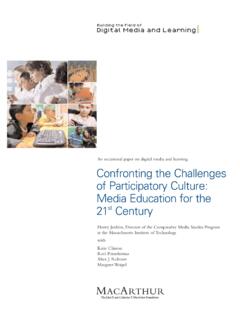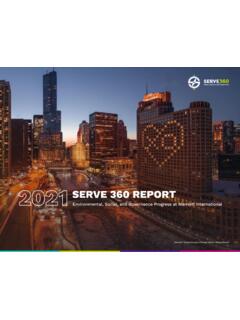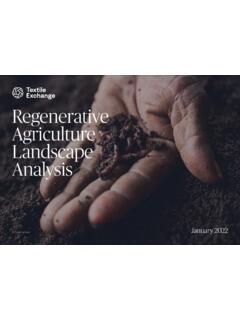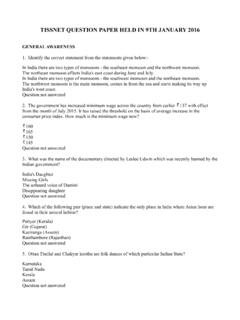Transcription of Sustainable healthy diets - Food and Agriculture Organization
1 Sustainable healthy DIETSGUIDING PRINCIPLESSUSTAINABLE healthy DIETSGUIDING PRINCIPLESFood and Agriculture Organization oF the united nationsWorld health organizationrome, 2019 The designations employed and the presentation of material in this information product do not imply the expression of any opinion whatsoever on the part of the Food and Agriculture Organization of the United Nations (FAO) or World Health Organization (WHO) concerning the legal or development status of any country, territory, city or area or of its authorities, or concerning the delimitation of its frontiers or boundaries.
2 The mention of specific companies or products of manufacturers, whether or not these have been patented, does not imply that these have been endorsed or recommended by FAO or WHO in preference to others of a similar nature that are not views expressed in this information product are those of the author(s) and do not necessarily reflect the views or policies of FAO or WHO. ISBN 978-92-5-131875-1 (FAO) ISBN 978-92-4-151664-8 (WHO) FAO and WHO, 2019 Some rights reserved.
3 This work is made available under the Creative Commons Attribution-NonCommercial-ShareAlike IGO licence (CC BY-NC-SA IGO; ). Under the terms of this licence, this work may be copied, redistributed and adapted for non-commercial purposes, provided that the work is appropriately cited. In any use of this work, there should be no suggestion that FAO or WHO endorses any specific Organization , products or services. The use of the FAO or WHO logo is not permitted. If the work is adapted, then it must be licensed under the same or equivalent Creative Commons licence.
4 If a translation of this work is created, it must include the following disclaimer along with the required citation: This translation was not created by the Food and Agriculture Organization of the United Nations (FAO) or WHO. FAO/WHO are not responsible for the content or accuracy of this translation. The original English edition shall be the authoritative arising under the licence that cannot be settled amicably will be resolved by mediation and arbitration as described in Article 8 of the licence except as otherwise provided herein.
5 The applicable mediation rules will be the mediation rules of the World Intellectual Property Organization and any arbitration will be conducted in accordance with the Arbitration Rules of the United Nations Commission on International Trade Law (UNCITRAL).Third-party materials. Users wishing to reuse material from this work that is attributed to a third party, such as tables, figures or images, are responsible for determining whether permission is needed for that reuse and for obtaining permission from the copyright holder. The risk of claims resulting from infringement of any third-party-owned component in the work rests solely with the , rights and licensing.
6 FAO information products are available on the FAO website ( ) and can be purchased through Requests for commercial use should be submitted via: Queries regarding rights and licensing should be submitted to: citation:FAO and WHO. 2019. Sustainable healthy diets Guiding principles..5 Introduction ..7 Aims of Sustainable healthy diets ..9 Guiding Principles for Sustainable healthy diets ..11 Actions for the implementation of Sustainable healthy diets ..13 SUMMARY PAPERS FROM THE INTERNATIONAL CONSULTATION ..15 SUMMARY PAPER 1: Background paper on healthy diets .
7 17 SUMMARY PAPER 2: The role of healthy diets in creating environmentally Sustainable food systems ..21 SUMMARY PAPER 3: The Role of culture, economics, and food environment in shaping choices for Sustainable diets ..25 SUMMARY PAPER 4: Territorial diets ..29 SUMMARY PAPER 5: Background paper on food safety ..33 Annex 1: Contributors to the consultation ..37 FAO/Hoang Dinh Nam5 Two of the major challenges of our times are malnutrition in all its forms and the degradation of environmental and natural resources. Both are happening at an accelerated pace. The State of Food Security and Nutrition in the World report (SOFI 2019) shows that the number of the undernourished has been slowly increasing for several years in a row, and at the same time the number of overweight and obese people all over the world is increasing at an alarming rate.
8 More than 820 million people go to bed hungry every night. In 2018, billion people experienced food insecurity at moderate levels, meaning they did not have regular access to nutritious and sufficient food. Overweight and obesity and their associated diet -related non-communicable diseases (NCDs) are contributing to 4 million deaths globally. Today, 2 billion adults and over 40 million children under five are overweight. Moreover, over 670 million adults and 120 million girls and boys (5-19 years) are obese.
9 Malnutrition is costly to the health of individuals, their wellbeing and productivity. It also has high socio-economic costs for societies in all regions of the diets are a major contributory factor to the rising prevalence of malnutrition in all its forms. Moreover, unhealthy diets and malnutrition are among the top ten risk factors contributing to the global burden of disease. In addition, the way we produce and consume food is taking a toll on the environment and natural resource base. For example, food production accounts for the use of 48 percent and 70 percent of land and fresh water resources respectively at the global , demographic and economic factors are also contributing to changing lifestyles and eating patterns, and subsequently putting pressure on resources for food production.
10 In 2014, the FAO/WHO Second International Conference on Nutrition (ICN2) acknowledged that: current food systems are being increasingly challenged to provide adequate, safe, diversified and nutrient rich food for all that contribute to healthy diets due to, inter alia, constraints posed by resource scarcity and environmental degradation, as well as by unsustainable production and consumption patterns . To address these challenges, the UN Decade of Action on Nutrition 2016 2025 puts a specific focus on the transformation of food systems to promote healthy diets that are sustainably produced and improve nutrition to achieve the global nutrition and diet -related NCD targets in line with commitments of ICN2 and the Sustainable Development Goals (SDGs).
















